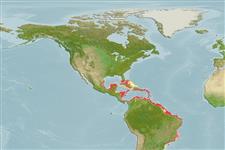Common names from other countries
>
Carangaria/misc (Various families in series Carangaria) >
Centropomidae (Snooks)
Etymology: Centropomus: Greek, kentron = sting + Greek, poma, -atos = cover, operculum (Ref. 45335).
More on author: Poey.
Environment: milieu / climate zone / depth range / distribution range
Ecología
marino; agua dulce; salobre demersal; anfidromo (Ref. 51243). Subtropical; 26°N - 28°S, 98°W - 34°W
Western Atlantic: southern Florida (USA) and the Mexican Gulf coast to Florianopolis, Brazil.
Tamaño / Peso / Age
Maturity: Lm ? range ? - ? cm
Max length : 72.0 cm TL macho / no sexado; (Ref. 40637); common length : 25.0 cm TL macho / no sexado; (Ref. 3713); peso máximo publicado: 5.0 kg (Ref. 26340)
Inhabits coastal waters, estuaries and lagoons, penetrating into freshwater; usually prefers very low brackish water or freshwater. Occasionally in hypersaline lagoons (Ref. 5217). Found over shallow soft bottoms (Ref. 5217). Feeds on fish and crustaceans. Its flesh is well appreciated (Ref. 27188).
Spawn in brackish waters in estuaries.
Fraser, T.H., 1978. Centropomidae. In W. Fischer (ed.) FAO species identification sheets for fishery purposes. West Atlantic (Fishing Area 31). FAO, Rome. Vol. 1-2. pag.var. (Ref. 3713)
IUCN Red List Status (Ref. 130435)
CITES (Ref. 128078)
Not Evaluated
Threat to humans
Harmless
Human uses
Pesquerías: escaso valor comercial; pesca deportiva: si
Más información
ColaboradoresImágenesStamps, Coins Misc.SonidosCiguateraVelocidadTipo de nataciónSuperficie branquialOtolitosCerebrosVisión
Herramientas
Special reports
Download XML
Fuentes de Internet
Estimates based on models
Preferred temperature (Ref.
115969): 24.9 - 28, mean 27.2 (based on 232 cells).
Phylogenetic diversity index (Ref.
82804): PD
50 = 0.5005 [Uniqueness, from 0.5 = low to 2.0 = high].
Bayesian length-weight: a=0.00794 (0.00657 - 0.00960), b=3.04 (2.99 - 3.09), in cm Total Length, based on LWR estimates for this species (Ref.
93245).
Nivel trófico (Ref.
69278): 4.2 ±0.74 se; based on food items.
Resiliencia (Ref.
120179): Medio, población duplicada en un tiempo mínimo de 1.4-4.4 años (tm=3-4; Fec=900,000).
Fishing Vulnerability (Ref.
59153): Moderate to high vulnerability (49 of 100).
